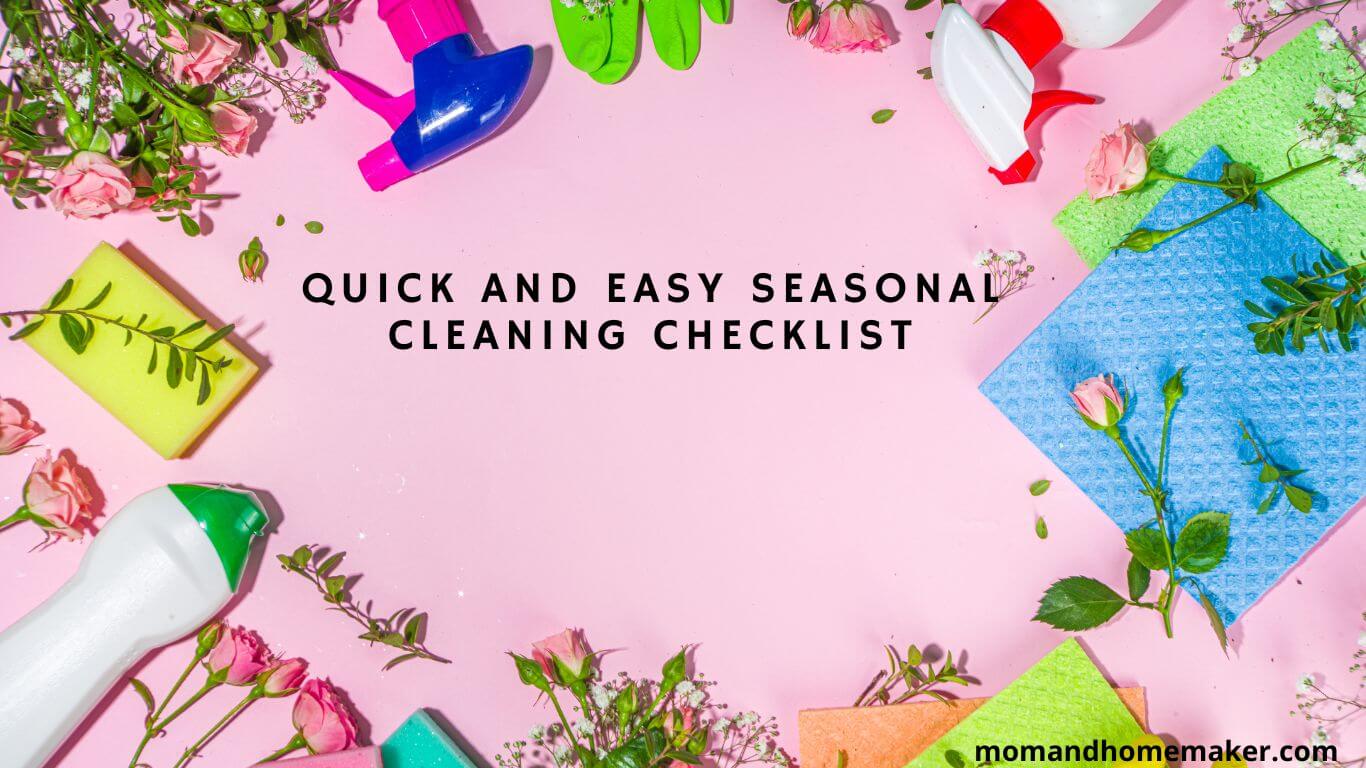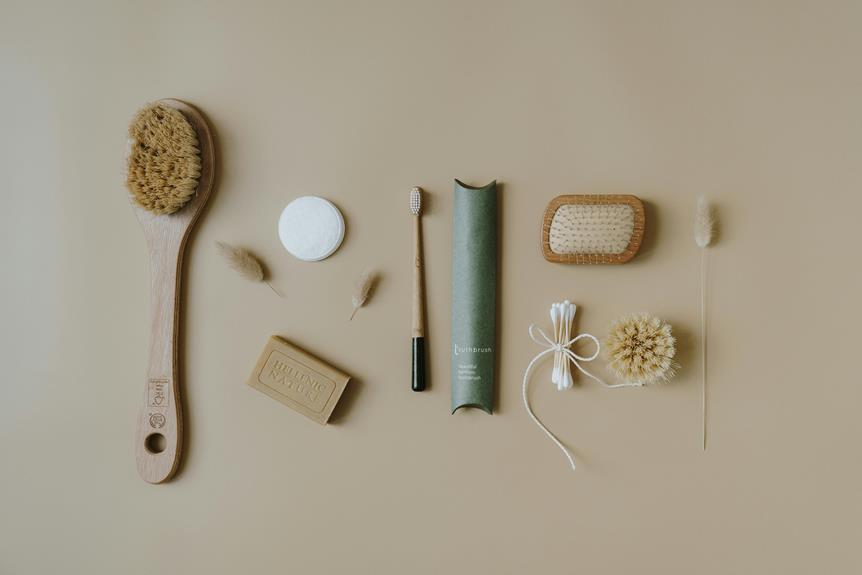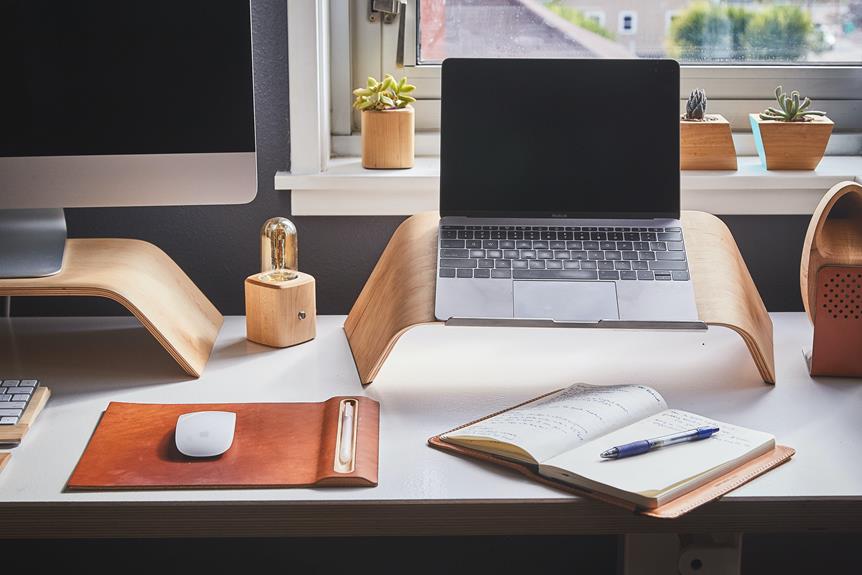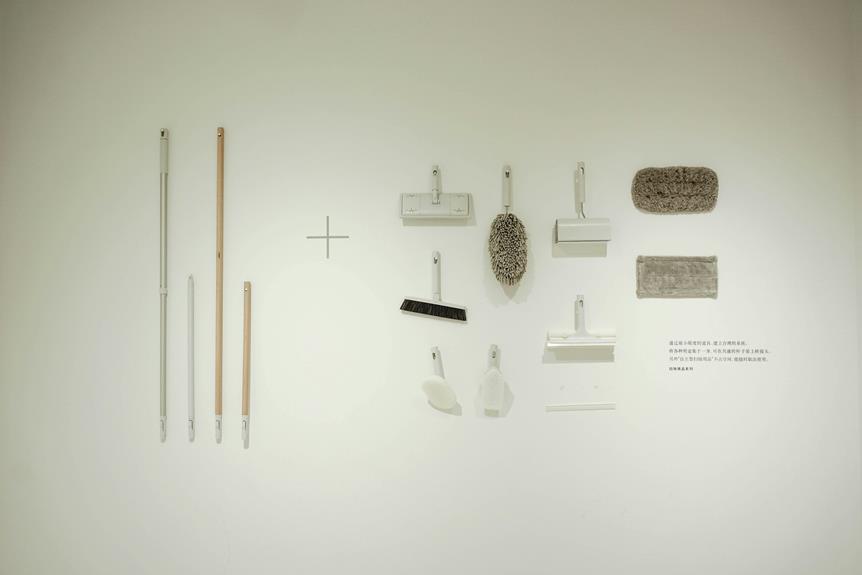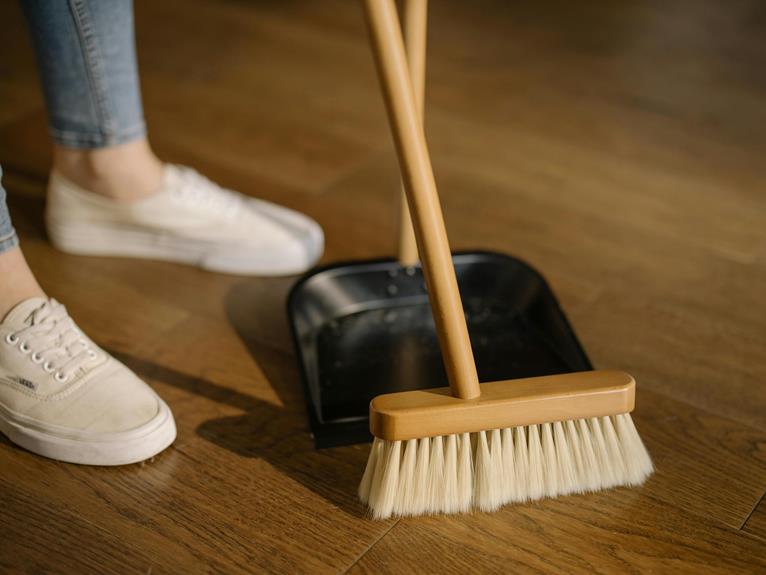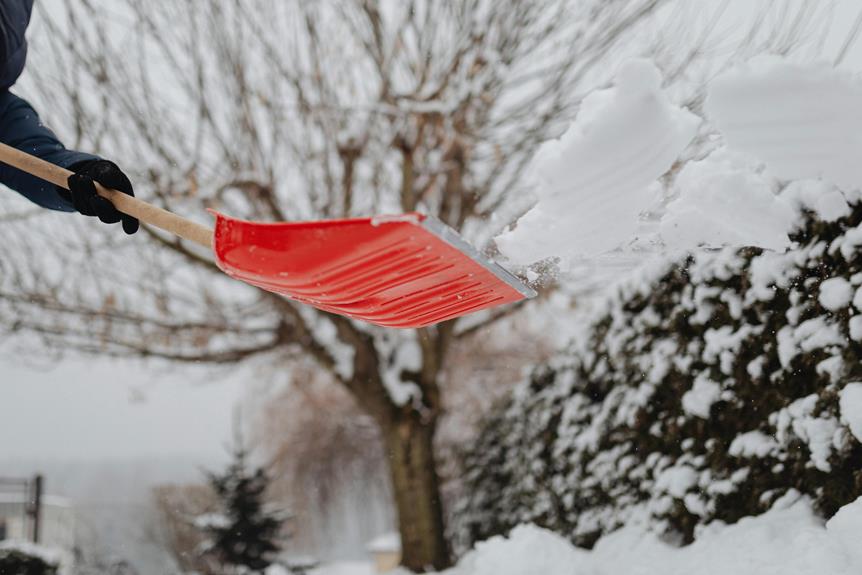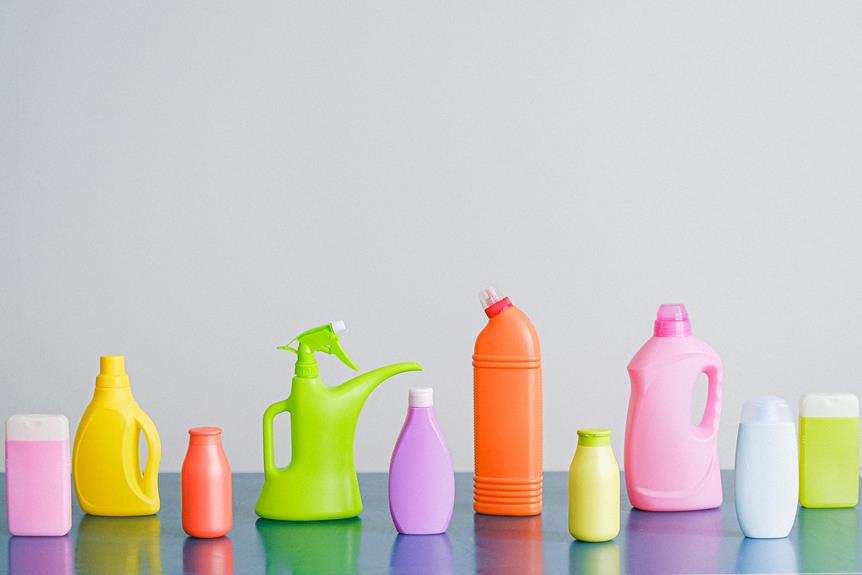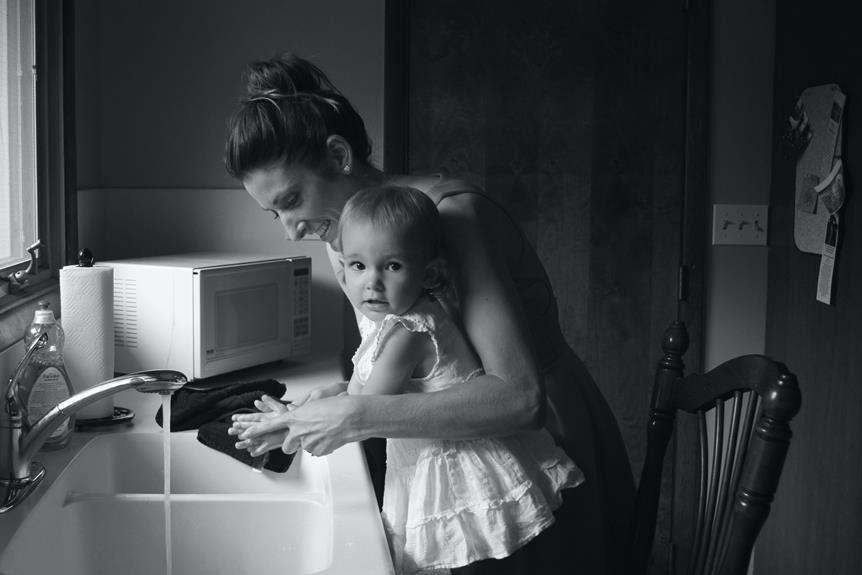With a simple checklist, you can tackle seasonal cleaning quickly and easily. I’ll guide you through each area of your home, providing tips and tricks along the way. Let’s transform your home into a haven of cleanliness with a stress-free seasonal cleaning routine.
Feel free to customize it based on your specific needs and preferences. And don’t forget to take breaks and reward yourself for a job well done.

Kitchen
Keeping your kitchen clean and organized is essential. Here’s a checklist to help you with your seasonal kitchen cleaning.
Having a well-organized kitchen not only improves the overall look of your home but also makes cooking and meal prep easier. Let’s start by organizing your kitchen. Begin by decluttering your countertops and cabinets. Get rid of unnecessary items and only keep the essentials within reach. Use storage solutions like drawer dividers, cabinet organizers, and hanging racks to maximize space and maintain order.
Focus on maintaining your kitchen. Start by deep cleaning your appliances. Take the time to clean the inside of your oven, microwave, and refrigerator. Wipe down surfaces, remove any food residue, and sanitize with appropriate cleaning products.
Don’t forget to clean the dishwasher and garbage disposal. It’s also important to clean and organize your pantry. Check for expired items, rearrange shelves, and group similar items together for easy access. This won’t only keep your pantry tidy but also help you keep track of what you need to restock.
Lastly, pay attention to the little details. Thoroughly clean your sink, removing any stains or buildup. Polish your faucets and handles to make them shine. Don’t forget to clean your windows, blinds, and curtains to let natural light in and create a welcoming atmosphere in your kitchen.
Bathroom
Cleaning and organizing the bathroom is an important part of maintaining a clean and comfortable space in my home. To start, I declutter and remove any unnecessary items, creating more space and making it easier to clean.
Then, I focus on cleaning the surfaces, such as the sink, countertops, and toilet. Using a suitable cleaner and scrub brush, I ensure that any dirt or stains are removed. I also pay special attention to thoroughly cleaning the shower and bathtub, getting rid of any soap scum or mildew.
To keep the bathroom fresh, I regularly replace towels, bath mats, and shower curtains. I make sure to clean and disinfect the toilet regularly and unclog any drains if needed.
Living Room
Now that the bathroom is clean and organized, let’s turn our attention to the living room. The living room is the heart of the home, where we gather with loved ones and create lasting memories. It’s important to keep this space tidy and organized while adding our personal touch.
Here are some ideas to help you organize and decorate your living room:
- Declutter and Simplify: Start by getting rid of any unnecessary items and clearing out clutter like old magazines and toys. Keep only the essentials to create a sense of space and openness.
- Create Zones: Divide your living room into different zones to make it more functional. Designate areas for lounging, reading, and entertainment. Use rugs, furniture placement, or room dividers to clearly define each zone.
- Add Storage Solutions: Invest in stylish storage solutions to keep your living room organized. Consider bookshelves, storage ottomans, or wall-mounted shelves to store books, toys, and other items. This will help keep the space tidy and free of clutter.
- Refresh Your Decor: Give your living room a fresh look by updating the decor. Change out throw pillows, curtains, or rugs to add a pop of color and texture. Consider adding artwork or family photos to personalize the space and make it feel inviting.
- Bring in Nature: Incorporate natural elements into your living room to create a calming atmosphere. Place potted plants or fresh flowers on side tables or shelves. Not only will this add a touch of greenery, but it will also improve the air quality in your home.
Bedroom
Creating a calm and organized bedroom is easy with these effective tips.
Start by decluttering your space and getting rid of any items you no longer need. This will create more space and make it easier to find what you need.
Once you’ve decluttered, focus on bedroom decor. Choose relaxing colors like soft blues or neutrals. Add cozy elements like throw pillows and blankets to make your bed a welcoming sanctuary. Invest in storage solutions like under-bed containers or a bedside table with drawers to keep things organized and out of sight.
Don’t forget about your closet. Use slim hangers to save space and keep clothes wrinkle-free. Install a shoe rack or use hanging organizers for your shoes. Use storage bins or baskets for accessories like scarves or belts.
Lastly, remember to regularly clean your bedroom. Dust surfaces, vacuum the floors, and change your bedding regularly. Opening the windows for fresh air can also create a rejuvenating space.
Laundry Room
Let’s shift our focus to the laundry room, where efficiency and cleanliness are key. This space can easily become cluttered and chaotic, but with organization and clever storage solutions, we can transform it into a functional and inviting area.
Here are five tips to help you achieve a well-organized laundry room:
- Sort and Label: Start by categorizing your laundry supplies into groups such as detergents, fabric softeners, and stain removers. Use clear bins or labels to keep everything organized and easily accessible.
- Utilize Wall Space: Take advantage of vertical space by installing shelves or hooks on the walls. This frees up counter space and provides a convenient spot to hang laundry bags, lint rollers, and other frequently used items.
- Invest in Storage Containers: Purchase stackable storage containers to store items like dryer sheets, clothespins, and lint brushes. These containers keep everything in one place and give your laundry room a clean and cohesive look.
- Create Folding Stations: Install a folding table or countertop to make folding and sorting laundry easier. You can also add wall-mounted drying racks for delicate items or clothes that need to air dry.
- Maximize Cabinet Space: If your laundry room has cabinets, make the most of them by using drawer dividers and organizers. This helps keep smaller items like socks and underwear separated and easy to find.
Entryway
When I step through the front door, the entryway greets me with its neat and organized atmosphere. It sets the tone for the rest of my home, instantly making me feel at ease and ready to relax. A well-organized entryway not only provides a functional space for coats, shoes, and keys, but it also creates a sense of belonging and pride in my home.
To keep my entryway clutter-free and inviting, I follow a simple organizational system. Here are some ideas that have worked wonders for me:
- Install hooks for coats and bags.
- Use a shoe rack or basket for shoe storage.
- Hang a key holder or tray for easy access.
- Keep a small dish or basket for loose change and small items.
In terms of decor, I add a stylish mirror for a quick last-minute check and place a small table or bench for added functionality. I also display some artwork or photographs to personalize the space and incorporate some plants or flowers for a touch of freshness.
By implementing these organization and decor ideas, my entryway becomes a warm and inviting space that welcomes me home every day. It not only helps me stay organized but also makes a positive impression on guests, making them feel immediately at home.
Belonging is a fundamental human need, and by creating an organized and aesthetically pleasing entryway, I foster a sense of belonging within myself and those who enter my home. It’s a small space that holds great significance in creating a welcoming environment, making me feel like I truly belong in my sanctuary.
Windows
Cleaning the windows in my home is a regular task to keep them sparkling and let natural light fill the rooms. Window maintenance is an important part of keeping your home fresh and inviting.
Here are some tips for keeping your windows clean and streak-free:
- Use a vinegar solution: Mix equal parts vinegar and water in a spray bottle and use it to clean your windows. Vinegar is a natural cleaner that removes dirt and grime without streaks.
- Use a microfiber cloth: Instead of paper towels or regular cloth, use a microfiber cloth to wipe your windows. Microfiber is absorbent and leaves fewer streaks.
- Clean the frames and sills: Don’t forget to clean the frames and sills of your windows. Use a damp cloth or small brush to remove dust and dirt from these areas.
- Avoid cleaning on sunny days: Cleaning windows on sunny days can cause the solution to dry quickly, leaving streaks. It’s best to clean on cloudy days or when the sun isn’t directly shining on them.
- Check for drafts: Regularly inspect your windows for drafts or air leaks. These can lead to energy loss and higher bills. Consider adding weatherstripping or caulking to seal gaps and improve insulation.
Taking care of your windows improves their appearance and makes your home more energy-efficient. By following these window maintenance tips and investing in energy-efficient window solutions, you can save money on energy bills and create a comfortable living environment.
Floors
To keep my home clean and tidy, I regularly maintain the floors using effective cleaning techniques. Floors are an important part of our living spaces, and proper floor maintenance not only keeps them looking fresh but also helps to extend their lifespan.
One important aspect of floor maintenance is deep cleaning. Deep cleaning involves going beyond the regular sweeping and mopping routine and thoroughly cleaning the floors to remove dirt, stains, and grime that may have accumulated over time.
When it comes to deep cleaning, different types of floors require different approaches. For hardwood floors, it’s important to use a gentle cleaner that’s specifically designed for wood surfaces. Avoid using too much water, as it can damage the wood. Instead, use a damp mop and a mild cleaning solution to gently clean the surface.
For tile or laminate floors, a mixture of warm water and a vinegar-based solution can be highly effective in removing dirt and grime. Be sure to use a mop or cloth that’s damp, but not soaking wet, to prevent any water damage.
In addition to deep cleaning, regular maintenance is key to keeping floors in top condition. This includes simple tasks such as sweeping or vacuuming to remove loose dirt and debris, as well as promptly wiping up any spills or stains to prevent them from becoming permanent.
Walls
Regularly maintaining the walls is an important part of keeping my home clean and looking its best. Here are some tips I use to keep my walls in great shape:
- Wipe down the walls: Dust, dirt, and grime can build up on the walls over time, making them look dull and dirty. To keep them looking fresh, I regularly wipe down the walls with a damp cloth or sponge to remove any buildup.
- Clean wall art: Wall art adds personality to any room, but it can also collect dust. To keep it vibrant and clean, I gently dust my wall art using a soft cloth or feather duster.
- Touch up paint: Walls can get scuffed or marked over time. To quickly cover up any blemishes or marks, I keep some touch-up paint in the same color as my walls on hand.
- Experiment with paint colors: Changing up the paint color on my walls is a great way to refresh the look of a room. I enjoy trying out different colors to create a new atmosphere and inject some excitement into my living space.
- Protect the walls: I take preventive measures to protect my walls from damage. Using furniture pads to prevent scratches, hanging wall art with care to avoid nail holes, and placing rugs or mats near high-traffic areas to prevent scuff marks.
Furniture
Maintaining clean and well-maintained furniture is crucial for keeping my home looking its best. Regular furniture upkeep not only helps prolong the lifespan of my cherished pieces but also creates a cozy and welcoming atmosphere that makes me feel truly at home.
When it comes to organizing my furniture, I prefer a simple and functional approach. I believe each piece should have a specific purpose and place in my home. This not only helps me stay organized but also fosters a sense of harmony and balance in my living space.
To better understand the importance of furniture maintenance and organization, let’s take a look at the table below:
| Furniture Maintenance | Furniture Organization |
|---|---|
| Regular dusting and polishing | Assigning specific purposes to each piece of furniture |
| Addressing stains and spills | Creating designated areas for different activities |
| Checking for loose screws or damaged parts | Maximizing storage space with furniture that has built-in storage |
| Rotating cushions and fluffing pillows | Arranging furniture to promote easy flow and conversation |
By regularly dusting and polishing my furniture, I ensure that it remains clean and shiny. Treating any stains or spills promptly helps prevent permanent damage. Regularly checking for loose screws or broken parts ensures that my furniture stays sturdy and safe. Lastly, rotating cushions and fluffing pillows maintain their shape and comfort.
In terms of organization, assigning specific purposes to each piece of furniture helps me make the most of my living space. For example, I designate an area for work, relaxation, and dining. This allows me to create distinct zones that cater to different activities and promote a sense of order.
Maximizing storage space is also important. I opt for furniture with built-in storage options, such as ottomans with hidden compartments or coffee tables with shelves. This helps me keep my belongings organized and out of sight, creating a clutter-free environment.
Finally, arranging furniture in a way that promotes easy flow and conversation is key. By positioning seating areas facing each other, I create a cozy and inviting space for socializing. This layout encourages interaction and fosters a warm atmosphere in my home.
Appliances
Taking care of my appliances is important for their longevity and optimal performance in my home. Proper maintenance not only saves me money in the long run but also improves energy efficiency. Here are some tips to keep my appliances in top shape:
- Refrigerator: Regularly clean the coils at the back or underneath to improve energy efficiency. Check the door seals for leaks and replace if necessary. Empty and clean the interior, removing any expired or spoiled food items.
- Oven: Use a gentle cleaner to wipe down the interior and remove any grease or food residue. Clean the oven racks separately by soaking them in warm, soapy water and gently scrubbing them. Check the oven’s gasket for signs of wear and tear and replace if needed.
- Washing machine: Clean the lint filter and remove any debris from the drain pump filter. Run a cleaning cycle with vinegar or a washing machine cleaner to eliminate built-up residue. Leave the door open after each use to prevent mold and mildew growth.
- Dishwasher: Check and clean the spray arms to ensure proper water flow and distribution. Remove any food particles from the filter and clean the door gasket with a mild detergent. Run a dishwasher cleaner through a cycle to remove mineral deposits.
- Air conditioner: Regularly clean or replace the air filters to maintain optimal airflow and energy efficiency. Remove any debris from the exterior unit and ensure there’s no blockage around it. Schedule professional maintenance annually to check for refrigerant leaks and ensure proper functioning.
Closet
My closet is a space that I often organize and declutter to keep it neat and functional. As someone who values a sense of belonging, I believe that a well-organized closet contributes to a peaceful and organized home environment. To help you achieve the same, here are some tips for organizing and decluttering your closet:
- Sort by category: Separate your clothes by type, such as tops, bottoms, dresses, and outerwear. This makes it easier to find what you need.
- Donate or sell unused items: If you haven’t worn a piece of clothing in over a year, it’s time to let it go. Consider donating it to someone in need or selling it online.
- Utilize storage solutions: Invest in storage bins, hanging organizers, and shoe racks to maximize your closet space.
- Create a ‘maybe’ pile: If you’re having trouble parting with certain items, create a separate pile for clothes you’re unsure about. Revisit this pile after a few weeks and decide if you can let them go.
- Color coordinate: Arrange your clothes by color to create a visually appealing and organized closet.
- Keep essentials within reach: Place frequently worn items at eye level or in easy-to-reach areas to save time when getting dressed.
- Maintain a seasonal rotation: Store out-of-season clothing in vacuum-sealed bags or under-bed storage containers to save space and keep your closet clutter-free.
- Limit sentimental items: While it’s nice to hold onto sentimental pieces, be selective. Keep only the ones that truly bring you joy and find a special place for them.
Garage
Organizing your home requires regular attention to the garage. This space is often used to store items that aren’t needed daily, and without proper organization, it can quickly become cluttered. To help you keep your garage clean and organized, here are some tips:
- Start by decluttering: Go through all the items in your garage and get rid of anything you no longer need or use. Donate or sell items that are still in good condition, and dispose of broken or unusable items.
- Categorize your items: Once you’ve decluttered, categorize the items in your garage. Group similar items together, such as tools, sports equipment, and gardening supplies. This will make it easier to find what you need.
- Create specific zones: Divide your garage into different zones for different purposes. For example, have a workspace zone for DIY projects, a storage zone for seasonal items, and a parking zone for vehicles. This will maximize space and keep everything organized.
- Use storage solutions: Invest in shelving, cabinets, and hooks to keep your garage organized. Install shelves to store boxes and bins, utilizing vertical space. Hang tools and equipment on hooks to keep them easily accessible.
- Regular maintenance: Make it a habit to regularly maintain and clean your garage. Sweep the floor, wipe down surfaces, and check for signs of pests or water damage. Staying on top of maintenance will prevent potential issues from becoming bigger problems.
Outdoor Spaces
Creating and maintaining outdoor spaces can be made easier by implementing effective design and maintenance strategies. Outdoor spaces such as patios, gardens, and landscapes play a vital role in creating a welcoming and inviting atmosphere. By focusing on the maintenance of your outdoor patio, garden, and landscape, you can create a space that not only looks beautiful but also functions well for your needs.
To keep your outdoor patio in good condition, there are a few key tasks to keep in mind. Regularly sweeping and cleaning your patio will prevent the buildup of dirt and debris. It’s also important to check for any cracks or damage and repair them promptly to ensure the longevity of your patio. Additionally, don’t forget to clean and maintain your outdoor furniture and decorations to keep them looking their best.
When it comes to maintaining your garden and landscape, several tasks should be included in your seasonal cleaning checklist. Regularly pruning and trimming your plants will promote healthy growth and prevent overgrowth. Removing any weeds or unwanted plants will also help maintain the overall appearance of your garden. Lastly, don’t forget to fertilize and water your plants regularly to ensure they thrive throughout the season.
By following these outdoor maintenance tips, you can create a space that’s visually appealing and functional for your needs. Whether you’re hosting a gathering or simply enjoying a quiet moment outdoors, a well-maintained outdoor space will provide a sense of belonging and allow you to make the most of your time outside.
Storage Areas
Organizing storage areas is an important part of seasonal cleaning. It helps declutter and maximize space, making it easier to find items when needed. Here are some tips for organizing small storage areas and maximizing space:
- Use vertical space: Install shelves or hanging organizers to make the most of the vertical space. This creates more storage options and keeps everything visible and accessible.
- Use bins and baskets: Invest in storage bins and baskets to group similar items together. Label them for easy identification and stack them to save space. This keeps things organized and adds aesthetic appeal.
- Hang items on doors: Install hooks or over-the-door organizers to hang frequently used items like cleaning supplies, tools, or shoes. This frees up floor and shelf space while keeping items within reach.
- Use clear containers: Opt for clear storage containers to store items that aren’t frequently used. This allows you to easily see what’s inside without opening every box and prevents items from getting lost or forgotten.
- Repurpose everyday items: Get creative and repurpose everyday items for storage. For example, use a hanging shoe organizer to store small items like scarves, gloves, or cleaning supplies. Use empty egg cartons to organize small hardware items like screws or nails.
Conclusion
Putting away the mop and dusting off the shelves, I can’t help but feel a sense of accomplishment. My home is now refreshed and ready for the changing seasons.
With each wipe and sweep, I’ve banished the dust bunnies and cobwebs, creating a clean and inviting space.
It’s like my house has put on a sparkling new outfit, embracing the beauty of the upcoming season.

